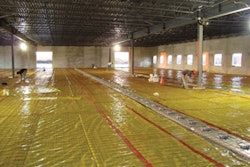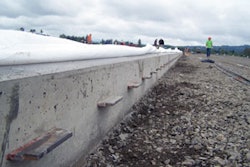Take a quick look at the current state of the Albert Sherman Center (ASC) construction site and it's clear that a massive amount of concrete is required to support the building. Not all concrete, however, is created equal. To make sure the concrete used to form the foundations and footings is strong enough, engineers monitoring the project routinely smash samples of it to bits.
"Most of the concrete in this building is rated at 4,000 pounds per square inch," said Kevin Sullivan, field engineer for Berry, the ASC construction manager and a division of Suffolk Construction. "The break tests we do are to make sure we maintain that strength throughout."
Different blends of concrete are designed to have different strengths, depending on the ratio of the materials used and the size of the bits of rock (known as the aggregate) in the mix. Keeping the mix consistent over the course of a large project takes strict controls because of the volume involved.
It will take approximately 8,175 yards of concrete to build the foundation walls and footings for the ASC. The trucks that bring concrete to the site carry 11 yards each, which adds up to about 743 truckloads.
For some areas of the ASC, concrete is poured directly from the spinning yellow mixing drums on the concrete trucks into the forms for footings and low walls. For the taller walls, and for areas not easily reached by a mixing truck, the mixer pours the concrete into the hopper of a pumping truck that uses a large boom and hose to pump the concrete to where it's needed.
To test the strength of the concrete, Berry contracts with UTS (Universal Testing Service) of Massachusetts, a construction monitoring firm that specializes in concrete analysis. Field staff from UTS take five samples of concrete from every 50 yards brought on site. Some samples are taken directly from the mixing trucks, others are taken from the end of the concrete pump hose. The samples are placed in cylindrical molds and left to dry or "cure."
"At its facility, UTS has a special machine that will compress a cylinder until it breaks, and measure the force needed to break it," Sullivan said. "They do break tests at seven, 21 and 28 days. The concrete is supposed to cure to full strength in 28 days."
Reports from the break-tests to date show that all the concrete placed at the ASC meets or exceeds its design strength, Sullivan said.
Copyright Targeted News Services
TNS MJ88-101117-3111456 StaffFurigay


















